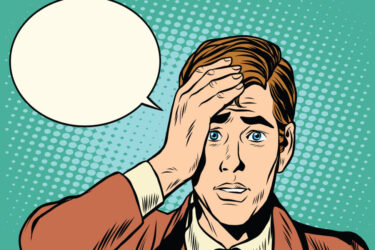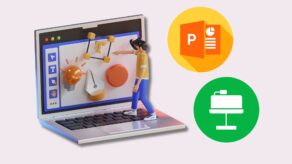“Don’t put yourself under the pressure of remembering a whole script word for word.“
What Was I Going To Say? 6 Ways To Remember Your Presentation
It’s unusual for a week to go by where one of our clients doesn’t say, “I’m just not good at giving presentations.”
There are several reasons we feel this way – feeling anxious or not being comfortable in front of a crowd are the obvious ones, but another challenge we come up against is struggling to remember what to say.
So what’s the solution? Firstly, it’s good to remind yourself that the audience doesn’t know your presentation or what you’re going to say, so they probably won’t notice if you miss things. Don’t put yourself under the pressure of remembering a whole script word for word.
If you’d still like some help with how to remember your presentation and keep on track, then here are some ideas:
1. To write or not to write?
For some of us, the very act of writing will help us to remember information. It’s an important part of the memory process. It all goes wrong when we write our ‘script’ and learn it verbatim. Big mistake. Huge. Why? Because you’re putting an incredible amount of pressure on yourself to remember thousands of words. The average person speaks at 140 words per minute, so if you have a 30-minute presentation, that’s over 4000 words to remember! No wonder you’re anxious. Not only that, but if you do remember all the words, you’ll end up sounding like a robot regurgitating information, which will not engage your audience. Even worse is when you write the script and then read it in front of the audience. A better way is to write down key phrases or headlines, so you remember the points you want to make – this also helps create a more conversational presentation.
2. Use visual aids
Visual aids are a great way to remember what you want to say and help your audience retain the information. Here’s the important takeaway: this doesn’t work if the slides are all bullet points and words. I can hear you thinking, wouldn’t this be the best way to help me remember by simply turning my script into a slide deck? Sadly, no. There was a fascinating study done by Dr John Medina, which features in his best-selling book Brain Rules. He took 600 people and asked 300 of them to watch a presentation which consisted only of slides with bullet points. The other 300 saw the same presentation, but the slides contained only images this time. Three days later, Dr Medina tested the memory of the audience.
The group who saw the slides with bullet points remembered only 10% of the presentation, compared to those who saw the images who remembered 65%.
How can this be? There are a few reasons. Firstly, it’s easier for our brains to remember images than it is to remember words. This is because different parts of our brain are activated when we see an image, which creates a ‘memory trace’. This memory trace is like a mental snapshot which we can recall more easily than words. Point three takes this concept a step further.
3. Make a memory house
Fans of the TV series Sherlock with Benedict Cumberbatch may be familiar with a memory palace, you may have also heard it called a memory house and is a popular technique when studying for exams. Cicero, the Roman lawyer, writer, and orator, was also keen on using it to remember his speeches.
You take the presentation’s main points and associate them with different parts of a house. The introduction could be the hallway, the main body of the presentation could be the living room, and the conclusion could be the bedroom. By associating different parts of your presentation with different parts of a house, it will be easier for you to remember what you need to say. For this to be as effective as possible, it needs to be your home or a house you’re familiar with, like your childhood home.
You can go further; in each room, you can associate key points with the furniture, decor, doors and windows. It works best if you start with objects on the left as you walk into the room and then work your way around the room from left to right.
The theory is that the memory house helps to create a mental map of the information, which makes it easier to remember. Additionally, creating the memory house can help solidify the information in your mind.
4. Relax and take your time
One of the worst things you can do when giving a presentation is to rush through it. When we speak quickly, we’re more likely to make mistakes and forget what we were going to say. This is because our brain can’t process the information in our heads as quickly as we speak. Speaking too fast will also make you appear nervous and unprepared. Instead, try to relax and take your time. Speak slowly and clearly, and remember that it’s okay if you need to pause for a moment to gather your thoughts.
5. Practice, practice, practice
The more you practice, the more likely you remember what you want to say. This is because when we rehearse something, we create neural pathways in our brain which become stronger with each repetition. So if you’re struggling to remember your presentation, try practising it as often as possible. Remember the first point about not learning the script verbatim; keep it conversational! You may find it useful to practice the ‘transition’ moments rather than the whole presentation. Many people find they can talk quite happily about each section but stumble on the transitions and then lose their thread. You could also try practising the opening and closing of the presentation, so you start and end strong.
6. Tell a story
Some of the best presentations are those that tell a story. When we hear a story, we remember it better than just hearing a list of facts. This is because stories create meaning and context, which helps our brains to remember the information. Additionally, when we hear a story, we can picture it in our minds, which also helps us to remember it.
If you’re still struggling to remember your presentation, don’t worry – there are a few extra things you can do. Many presenters still use cue cards; just ensure you make frequent eye contact with the audience and don’t use them as a crutch. You can also record yourself on your smartphone if you can bear it. Listen back and identify areas where you tend to forget what you are going to say. With a bit of practice, you’ll be able to give a presentation without forgetting a single thing!
The Power Of Visual Aids from Body Talk on Vimeo.




















